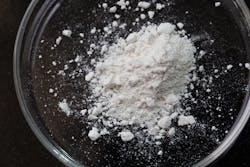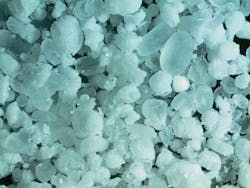Material classification for fine powders
Fine powders often need to be separated by particle size to ensure uniformity and effectiveness in a mixture or product. However, because many material classification technologies are available, determining which type is most suitable for your powder can be challenging. It is important to take an unbiased look at the various powder classification methods available to identify the solution that will best fit your powder separation needs.
This article will explore the different types of classification technologies, including mechanical screeners — gyratory, centrifugal, vibratory, high-energy and ultrasonic — as well as air classifiers — both with and without classifying wheels.
Understanding your material
To select the most suitable classifying technology, you must first understand your material’s particle size, shape and bulk density. With respect to particle size, simply stating a mesh size for separation is insufficient and leaves too much opportunity for error. For instance, is the mesh market grade, U.S. grade, tensile bolt cloth (TBC), stainless steel or nylon? To prevent errors, measure particle size in microns. A micron equals one-thousandth of a millimeter — too small for the naked eye to see. For instance, bacteria might have a particle size around 0.5 micron, while sand would have a particle size in the tens or hundreds of microns. Mesh-to-micron conversion charts are available online, if needed.
Particle shape is also extremely important. For example, a grain of rice appears to have a different particle size depending on whether it is being viewed from the side or from the end. It can be difficult to properly separate particles by size without knowing their true shape. Also, some particles have rough rather than flat or smooth edges. Such particles will have more difficulty passing through a square screen opening. Processing rates will vary depending on whether the particles are irregularly shaped or spherical.
A powder’s bulk density is its weight per unit of volume. For example, one pound of metal powder would fit into a small jar, but one pound of packing peanuts is going to be a huge bag. Depending on the material’s bulk density, the overall weight may be the same, but the volume of material being processed may be drastically different. This can quickly change the processing time for a classification process from a few hours to a few days.
Under the right conditions, most powders and bulk solids can be explosive. A thorough understanding of a material’s properties will reveal at what stages the material may present an explosion risk. For example, the granulated sugar in your kitchen cabinet is not at risk of exploding, but fine sugar dust is extremely explosive. Knowing the material’s explosion properties, including its KSt and Pmax values will help determine its tendency to ignite. KSt is a relative measure of a material’s explosion severity compared to other materials, and Pmax is the maximum pressure a material can generate during an explosion event.
It is also important to consider a material’s hygroscopicity, or ability to absorb moisture. Hygroscopic powders absorb water from humidity in the air, which increases their cohesion and decreases their flowability. For example, regardless of particle size, sugar will typically process at a completely different rate in the Midwest than it will in the Caribbean, because the Caribbean has a higher average humidity.
Finally, it is important to know the material’s particle size distribution (PSD). PSD is an index indicating what particle sizes are present in a material and in what proportions. For example, if a material has a D10 of 50 microns, a D50 of 100 microns and a D90 of 150 microns, then 10% of the particles are smaller than 50 microns, 50% of the particles are smaller than 100 microns and 90% of the particles are smaller than 150 microns.
Fine powder separation equipment
Fine powder separation equipment operates by one of two mechanisms: mechanical separation or air classification. Mechanical separation uses screens that allow small particles to pass through while holding back and redirecting oversized particles. Air classification uses airflow to separate smaller, lighter particles from larger, heavier particles.
Mechanical separation equipment
Gyratory separators, also known as tumblers, use a three-dimensional, circular motion to match the effect of hand sifting. This gentle, swirling motion is required for some materials with light or delicate particles. For example, disposable diapers contain superabsorbent polymers that are not effective if broken.
Centrifugal separators are used for simple, high-rate applications that require only a single separation. A centrifugal separator uses rotational motion to throw the material against a cylindrical screen, which allows smaller particles to pass through while trapping larger particles to be discharged at a different point. Centrifugal separators typically operate under vacuum or positive pressure and are most often used for direct, in-line separation in pneumatic conveying systems. One drawback to centrifugal separation is that, if something breaks inside the machine, determining the problem can be difficult because the system is enclosed.
Standard screeners, also called vibratory screeners, have been around for more than eighty years. While not much has changed during that time, several different versions are available. Standard screeners use an unbalanced weight to generate vibration, similar to the mechanism inside a cell phone that makes the device vibrate. This vibration encourages sifting and is typically four to five times the force of gravity on the x and y axes.
High-energy sifters or screeners redirect the vibratory energy up and through the screening surface. Only a few high-energy sifter options are on the market, but both round and rectangular screen shapes are available, depending on the application’s material feed rate. As with the standard screener, the high-energy sifter vibrates at four to five times the force of gravity on the x and y axes, but unlike the standard screener, the high-energy screener also vibrates aggressively on the z axis at 400 to 500 times the force of gravity. This vibration keeps the screen clean and is beneficial for high-bulk-weight materials but does not work well with lightweight materials.
Ultrasonic generators have also been around for a long time and work effectively with standard screeners. An ultrasonic generator is attached to the screen inside a screener. While the screener vibrates, the device sends an ultrasonic signal directly to the screen mesh, causing each wire in the screen mesh to vibrate independently from the screener’s overall vibration. This ultrasonic vibration breaks the surface tension between the material and the screen, allowing particles to pass through more easily. This method cannot be used in applications where the material is too fine or too coarse, however, and is one of the more expensive classifying options.
Air classification equipment
Air classification is typically used for very fine separation, as it can separate particles smaller than 20 microns. Air classifiers can be divided into two types: those that use a classifying wheel and those that do not. For air classification with a classifying wheel, airflow moves against its centrifugal action from the outside of a classifying chamber toward the center. The classifying wheel spins at a high rate of speed on a vertical axis inside the chamber. The wheel has blades or fins arranged in a ring extended parallel to the wheel’s axis of rotation. As the wheel spins, the airstream flows through the wheel, carrying finer particles to a discharge at the top of the chamber, while coarser particles fall to the bottom of the chamber. One drawback of this method is that running air into a plant is quite costly.
An elbow jet air classifier does not have a classifying wheel or any rotating parts. Instead, it utilizes convex surfaces and a phenomenon called the coandá effect to separate particles by size. The coandá effect is the tendency of a fluid jet to stay attached to a convex surface, similar to the way water flows around your finger under a running faucet. In an elbow jet air classifier, smaller, lighter particles stay closer to the curve, while larger, heavier particles stray farther from the curve. There are typically two to three separations.
A main benefit to air classifying without a wheel is that the wheel tends to degrade or wear over time. For example, separating titanium powder for 3D printing requires an air classifier without a classifying wheel avoid degradation or foreign contaminants. Air classification without a classifying wheel can be expensive, but it does allow materials to be classified to smaller than one micron.
Lastly, while cyclonic separation was originally designed for collecting dust, some manufacturers now use it for particle size separation. Cyclonic separation is a method of removing particulates from an air, gas or liquid stream using a vortex instead of filters. Facilities can reuse the fines or the coarse material separated by the cyclonic separator. Traditionally, a cyclone is not seen as the most effective type of air classification, but it can serve a purpose.
Choosing the best solution
Selecting the best classification method for your application depends on many factors. Always start by knowing your material, so you can identify the classifying challenges you may face, such as mesh blinding, issues with organic material, lower throughput rates, high initial investment costs and additional maintenance. Then review the following questions to discover the priorities:
- What are the material properties?
- What size do you need to classify?
- What is the allowable yield loss?
- What is the raw material cost?
- What is the feed rate?
- What is your upstream feeding process?
- How many separations do you need?
- How much can you spend?
The answers to these questions, combined with any outside factors that may affect your product will help you make the best, most informed equipment selection to ensure uniformity.
Kelly Froehlich is the marketing content manager at Spec Engineering, a Gray company, in Plainfield, Illinois. She holds a B.S. in marketing and business administration from Aurora University and has more than five years of experience in content creation, website management, email marketing and event planning. She can be reached at [email protected] or 815-676-5006 ext. 444.
Edel Rodriguez is the vice president of sales at Spec Engineering. He served in the U.S. Army in Intelligence and has a B.S. in civil engineering from the University of Miami. Edel has a vast knowledge of the effects of particle size and shape on sieving and separation and has worked with mechanical separation using ultrasonics, air classification and high-intensity screening technologies. He can be reached at [email protected] or 815-676-5006 ext. 320.



